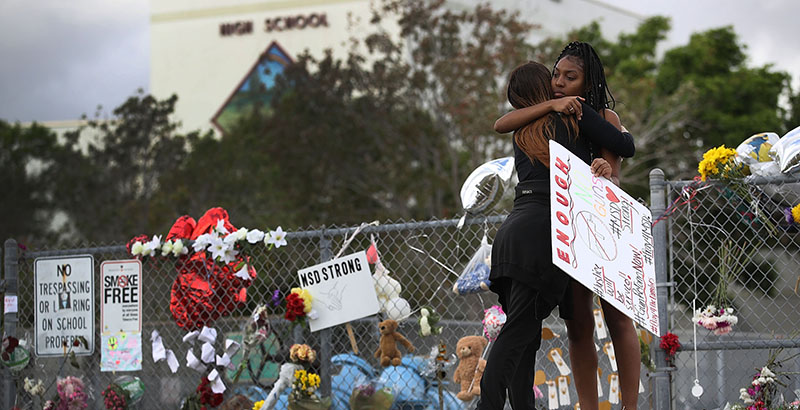Government Watchdog Report Finds No Evidence for Controversial Claims That Reducing Student Suspensions Could Benefit School Shooters

A federal watchdog report released Thursday found no evidence to support a controversial theory — elevated by conservative lawmakers after the 2018 school shooting in Parkland, Florida — that lax school discipline policies play a role in such attacks.
The Government Accountability Office report, which found “no empirical research” linking school discipline policies and preventing school shootings, offers new fodder for the controversy surrounding the decision by Education Secretary Betsy DeVos to rescind Obama-era guidance that sought to reduce student suspensions amid “unexplained racial disparities” in student punishments. DeVos scrapped the discipline guidance after a White House commission report argued that they could have made schools less safe. The commission, which DeVos led, was formed in response to the 2018 mass school shooting in Parkland, Florida, and sought to prevent future carnage.
The GAO report landed as student activists nationwide demand less punitive approaches to maintaining order in classrooms, including the removal of police from schools. Though school shootings have long motivated demands for school-based police and strict discipline policies, critics have long decried racial disparities in student arrests and suspensions. This summer, those concerns — and outrage over the death of George Floyd at the hands of Minneapolis police — have led districts across the country to sever long-standing contracts with police departments and re-examine their discipline strategies.
Discipline reforms in Broward County schools became a focal point after the Parkland shooting, when Sen. Marco Rubio, Republican of Florida, and conservative pundits accused district efforts to reduce suspensions — and the Obama-era guidance — of contributing to the shooting, arguing that lax school discipline allowed the alleged gunman to avoid sufficient police scrutiny. The suspect had been expelled from school prior to the shooting, and a state commission later concluded that the district discipline policy wasn’t relevant to the campus attack.
Though the watchdog report didn’t find evidence linking suspensions and other discipline approaches to the prevalence of school shootings, research is mixed on how these policies affect campus violence more broadly. The watchdog report doesn’t examine the link between campus police and school shootings in particular, but there’s no evidence to suggest that officers are effective in preventing such attacks, according to a literature review by the WestEd Justice and Prevention Research Center.
Because school shootings are statistically rare and the motives behind them vary considerably, it’s difficult for researchers to pinpoint how school discipline policies “affect an individual’s propensity toward violence,” the watchdog report noted.
The report defines school shootings broadly, focusing on events where “a gun is fired on school grounds, on a bus, during a school event, during school hours, or right before or after school.” As such, data could include events that go beyond the general public’s perception of a “school shooting.” Police officers were the shooters in roughly 4 percent of incidents, for example, including occasions when officers fired their guns due to a perceived campus threat and, in one incident, when a school-based officer died due to suicide. The methodology seeks to highlight incidents “where students or staff were at risk,” said report author Jacqueline Nowicki, director of the office’s education, workforce and income security team.
Despite the dearth of evidence linking discipline policies to school shootings, the GAO did identify several trends that could help educators respond proactively by crafting policies “that are more tailored to the types of shootings that are more likely to happen in their particular situation,” Nowicki said.
In the past decade, current or former students comprised roughly half of school shooters, according to the report, and campuses subjected to attacks varied widely in terms of the schools’ racial and socioeconomic makeups. Shootings were more frequent in urban schools with large shares of students of color and those from low-income households. Disputes, such as those stemming from gang violence, were the primary impetus behind these attacks. Students were less likely to be the perpetrators and incidents typically occurred outside the school building.
But suburban and rural districts with large shares of wealthier and white students suffered a larger share of suicides and “school-targeted shootings,” such as the one in Parkland, the GAO found. Such targeted shootings accounted for more than half of the 166 school-based fatalities between 2009 and 2019. In these schools, the perpetrators were more often students or former students.
Because of differing contexts, it’s “not enough to look at the frequency of occurrence, but to dig down a little bit and look at what types of shootings are happening in what types of schools,” Nowicki said. “That’s important because what you decide to do about it may be a little bit different.”
But conversations about school discipline don’t center entirely on school shootings, and the watchdog report certainly won’t settle the heated debate over how to best maintain classroom order. In its final report, the White House school safety commission argued that the Obama-era guidance “may have paradoxically contributed to making schools less safe.” The watchdog report doesn’t rule out that possibility.
Nothing in the report “contradicts the fact that the previous administration’s guidance robbed teachers of control of their classrooms,” Education Department spokeswoman Angela Morabito said in an email. “That guidance may have been well-intentioned, but it was dangerously flawed.”
However, it’s difficult to draw “bottom-line conclusions” about discipline approaches because research on their efficacy varies widely, the report noted. Evidence on a spectrum of interventions — including suspensions and teaching students to regulate behaviors through social-emotional learning — remains mixed.
Help fund stories like this. Donate now!

;)
